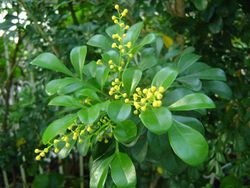Difference between revisions of "Aglaia"
From Wikur Essential Oils and Fragrances
(→Chemical Constituents) |
(→Chemical Constituents) |
||
| Line 21: | Line 21: | ||
* [[Caryophyllene oxide]] : 1,75 % | * [[Caryophyllene oxide]] : 1,75 % | ||
* [[beta-elemene]] : 0,82 % | * [[beta-elemene]] : 0,82 % | ||
| + | * [[gamma-elemene]] | ||
* [[alpha-copaene]] : 0,55 - 4,03 % | * [[alpha-copaene]] : 0,55 - 4,03 % | ||
* [[3,4-dimethyl-3-cyclohexene-1-carboxaldehyde]] : 4,35 % | * [[3,4-dimethyl-3-cyclohexene-1-carboxaldehyde]] : 4,35 % | ||
| Line 38: | Line 39: | ||
* [[alpha-muurolene]] : 0,76 % | * [[alpha-muurolene]] : 0,76 % | ||
* [[gamma-muurolene]] : 0,88 % | * [[gamma-muurolene]] : 0,88 % | ||
| − | |||
* [[bicycloelemene]] | * [[bicycloelemene]] | ||
* [[Cadina-1,4-diene]] : 0.61 % | * [[Cadina-1,4-diene]] : 0.61 % | ||
Revision as of 12:17, 10 July 2017
Contents
Classification
- Botanical Name : Aglaia odorata
- Other Names : Chinese Perfume Tree
- CAS Number : 85480-33-7
- Origin : Cambodia, Thailand, Vietnam, Laos.
Extraction Method
- Parts Used : Flowers
- Solvent Extraction
- Physical Description : yellow to brown liquid
Olfactory Description
- Family :
- Perfumery Note: Top note
- Floral fruity sweet slightly green tea peach pear fruit
Chemical Constituents
- alpha-humulene : 14,05 - 17,1 %
- Methyl linolenate : 0,91 %
- ethyl linolenate : 20,77 %
- linalool : 0,20 %
- germacrene D : 0,95 - 20,3 %
- Caryophyllene oxide : 1,75 %
- beta-elemene : 0,82 %
- gamma-elemene
- alpha-copaene : 0,55 - 4,03 %
- 3,4-dimethyl-3-cyclohexene-1-carboxaldehyde : 4,35 %
- Beta-caryophyllene : 3,78 - 10,2 %
- alpha-himachalene : 12.7 %
- beta-humulene-7-ol : 4 %
- ethyl palmitate : 1,08 %
- delta-cadinene : 27 %
- muurola-4,10(14)-dien-1β-ol
- Methyl jasmonate : 3,55 %
- beta-cubebene : Traces
- Methyl epi-jasmonate : 0,76 %
- Cis-cis-alpha-bisabolene oxide : 0,85 %
- Methyl palmitate : 0,18 %
- n-hexadecanoic acid : 1,73 %
- beta-bisabolene : 2,01 %
- alpha-muurolene : 0,76 %
- gamma-muurolene : 0,88 %
- bicycloelemene
- Cadina-1,4-diene : 0.61 %
Aromatherapy
http://wikiwel.com/wikihealing//index.php?title=Aglaia_odorata
